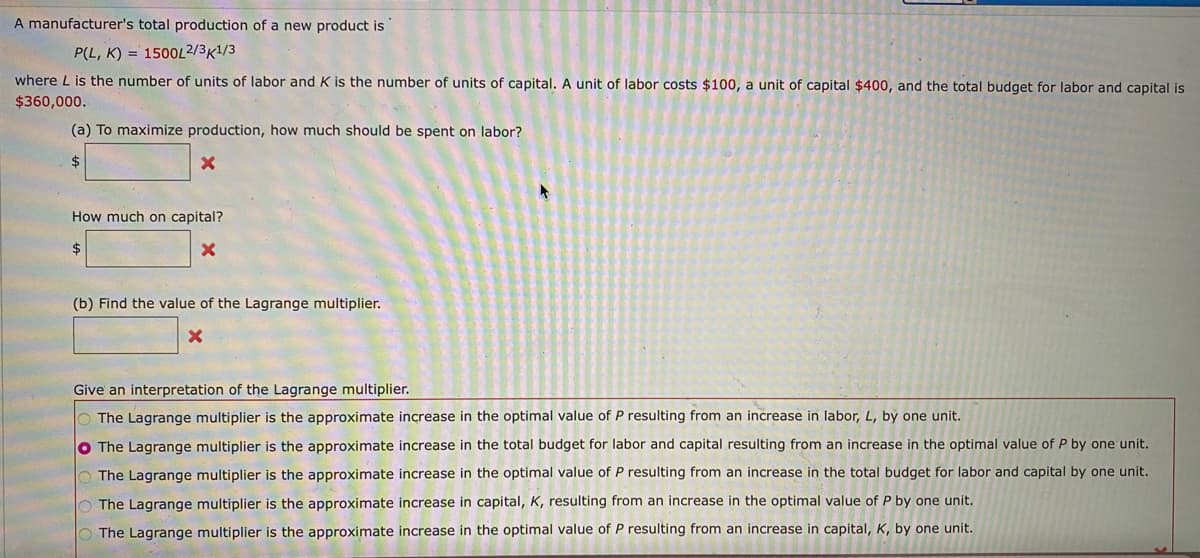A manufacturer's total production of a new product is P(L, K) = 1500L2/3K1/3 where L is the number of units of labor and K is the number of units of capital. A unit of labor costs $100, a unit of capital $400, and the total budget for labor and c. $360,000. (a) To maximize production, how much should be spent on labor? 2$ How much on capital? $ (b) Find the value of the Lagrange multiplier. Give an interpretation of the Lagrange multiplier.
A manufacturer's total production of a new product is P(L, K) = 1500L2/3K1/3 where L is the number of units of labor and K is the number of units of capital. A unit of labor costs $100, a unit of capital $400, and the total budget for labor and c. $360,000. (a) To maximize production, how much should be spent on labor? 2$ How much on capital? $ (b) Find the value of the Lagrange multiplier. Give an interpretation of the Lagrange multiplier.
College Algebra (MindTap Course List)
12th Edition
ISBN:9781305652231
Author:R. David Gustafson, Jeff Hughes
Publisher:R. David Gustafson, Jeff Hughes
Chapter6: Linear Systems
Section6.8: Linear Programming
Problem 3SC: In Example 3, if the accountant earns a profit of 100 on each individual return and a profit of 175...
Related questions
Topic Video
Question

Transcribed Image Text:A manufacturer's total production of a new product is
P(L, K) = 1500L2/3K1/3
where L is the number of units of labor and K is the number of units of capital. A unit of labor costs $100, a unit of capital $400, and the total budget for labor and capital is
$360,000.
(a) To maximize production, how much should be spent on labor?
2$
How much on capital?
$
(b) Find the value of the Lagrange multiplier.
Give an interpretation of the Lagrange multiplier.
O The Lagrange multiplier is the approximate increase in the optimal value of P resulting from an increase in labor, L, by one unit.
O The Lagrange multiplier is the approximate increase in the total budget for labor and capital resulting from an increase in the optimal value of P by one unit.
The Lagrange multiplier is the approximate increase in the optimal value of P resulting from an increase in the total budget for labor and capital by one unit.
O The Lagrange multiplier is the approximate increase in capital, K, resulting from an increase in the optimal value of P by one unit.
O The Lagrange multiplier is the approximate increase in the optimal value of P resulting from an increase in capital, K, by one unit.
Expert Solution
This question has been solved!
Explore an expertly crafted, step-by-step solution for a thorough understanding of key concepts.
This is a popular solution!
Trending now
This is a popular solution!
Step by step
Solved in 3 steps with 3 images

Knowledge Booster
Learn more about
Need a deep-dive on the concept behind this application? Look no further. Learn more about this topic, advanced-math and related others by exploring similar questions and additional content below.Recommended textbooks for you

College Algebra (MindTap Course List)
Algebra
ISBN:
9781305652231
Author:
R. David Gustafson, Jeff Hughes
Publisher:
Cengage Learning

Linear Algebra: A Modern Introduction
Algebra
ISBN:
9781285463247
Author:
David Poole
Publisher:
Cengage Learning

Algebra for College Students
Algebra
ISBN:
9781285195780
Author:
Jerome E. Kaufmann, Karen L. Schwitters
Publisher:
Cengage Learning

College Algebra (MindTap Course List)
Algebra
ISBN:
9781305652231
Author:
R. David Gustafson, Jeff Hughes
Publisher:
Cengage Learning

Linear Algebra: A Modern Introduction
Algebra
ISBN:
9781285463247
Author:
David Poole
Publisher:
Cengage Learning

Algebra for College Students
Algebra
ISBN:
9781285195780
Author:
Jerome E. Kaufmann, Karen L. Schwitters
Publisher:
Cengage Learning